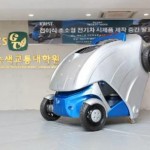
The Armadillo-T is pretty petite as it is, but when it comes time to fit into tight parking spaces, the all-electric car can do even better. The four-wheel-drive compact, which integrates a design similar to an armadillo's shell, includes seating for two, a 13.6 kWh battery pack and four in-wheel motors, allowing the rear half of the vehicle to fold upwards at the press of a button. Designed by a group of researchers from the Korea Advanced Institute of Science and Technology (KAIST), the prototype packs plenty of other high-tech features, too, including cameras that sub in for side-view mirrors, smartphone control and a ten-minute fast charge mode that nets 100 kilometers of range. The transporter is still a long way from reaching a production line, but it could one day serve to help ease congestion in overcrowded cities, letting you park in slots far too small to accommodate four wheels today.
Filed under: Transportation
Comments
Source: Phys.org
 This Korean electric car concept provides hassle-free parking even in the busiest of places. It’s even easier than stowing away your bags in the luggage compartment. Continue reading
This Korean electric car concept provides hassle-free parking even in the busiest of places. It’s even easier than stowing away your bags in the luggage compartment. Continue reading  This Korean electric car concept provides hassle-free parking even in the busiest of places. It’s even easier than stowing away your bags in the luggage compartment. Continue reading
This Korean electric car concept provides hassle-free parking even in the busiest of places. It’s even easier than stowing away your bags in the luggage compartment. Continue reading 
